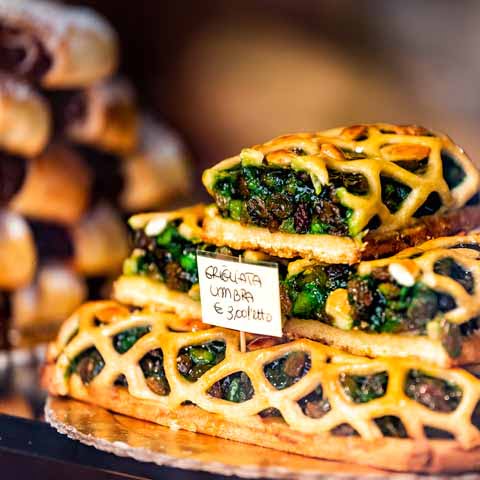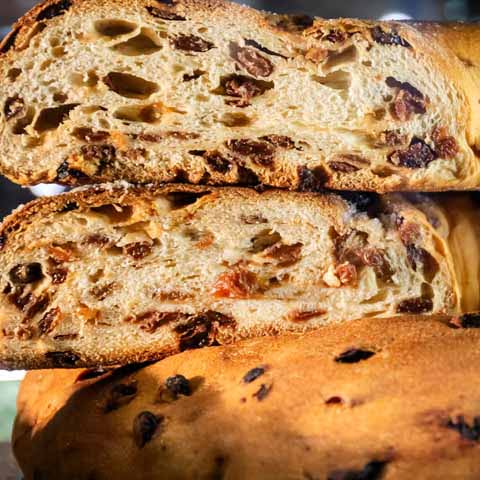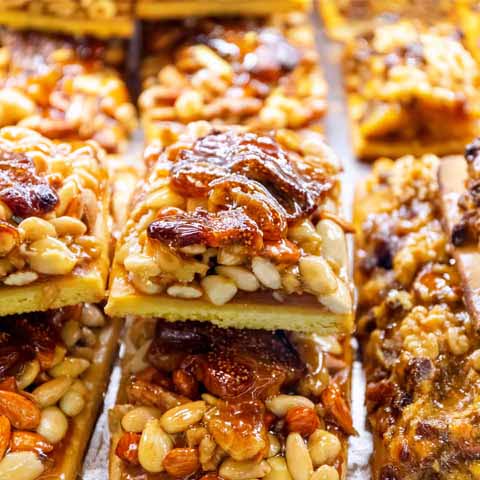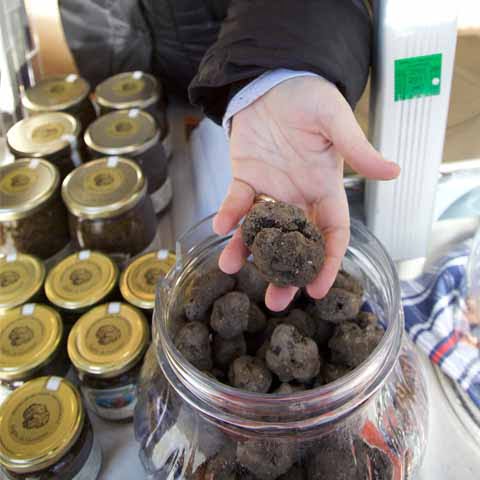Nestled into the heart of Italy just south of the Apennine Mountains is the quaint town of Assisi. This beautiful medieval town that sits upon a hill in the middle of the Italian countryside is widely known for the simple and authentic lifestyle of its residents. The people of this city treasure natural beauty, incorporating it into many facets of their daily life, including their food. The cuisine of Assisi is traditional, fresh and pure, and may just leave you refusing anything less when it comes to mealtime.
Despite its small size and largely rural surroundings, the city is one of the most visited pilgrimage sites in Italy. Assisi was the birthplace of the thirteenth century Saint Francis who is credited with establishing the Franciscan Order. Saint Francis devoted his life to communing regularly with nature and living the simplest version of life to dedicate himself more fully to spreading the message of Jesus Christ to all.
St. Francis is in many ways the livelihood and legacy of Assisi, so it seems only fitting that the city’s cuisine also reflects the saint’s love for simplicity. Much of the cuisine of this town is basic in that the food is whole and only sparingly flavored with items locally cultivated such as extra virgin olive oil, honey from the Subasio Park, herbs, beans, truffles, and Cannara onions. The secret to Assisi’s mouthwatering cuisine is fresh ingredients that are cooked slowly, resulting in flavorful preparations of each dish.
The honey from Subasio Park is considered a delicacy in Assisi and has often times been called the food of the Gods. This delicious honey is flavorful and aromatic, thanks to the park keeping nature intact and the variety of botanical species flowering within the park.
One of the most important staple ingredients in Assisi is truffles, which grow in Subasio Park. These prized fungi are rather elusive as they need just the right atmosphere to thrive, which is typically beneath damp leaves on the forest floor. Pigs were once used to find the prized delicacy, but as the pigs often ate what they found, specially trained dogs are now used to sniff them out. The nearby town of Norcia is renowned for its black truffles, often referred to as black gold.
When it comes to dining in Assisi, be prepared to spend a couple of hours at the table. Italians enjoy a largely slower paced lifestyle and treasure the time spent with family and friends around a table laden with good food and fine wine.
APPETIZERS
As is the case in most of Italy, the main appetizer enjoyed in Assisi is an assortment of locally made cured meats and cheeses served with accompaniments such as fresh bread or vegetables. Common cured meats in Assisi and the surrounding area include prosciutto di Norcia, lombetto, lonza, capocollo, and ciauscolo. In terms of cheeses, expect to find plenty of sheep milk and goat milk cheeses in addition to ricotta salata and the divine caciotta al tartufo (a semi-soft cheese infused with truffle). In Assisi, typical pairings to the cured meats and cheeses include arugula, baby artichokes, olives, and, of course, bread.
Another common appetizer throughout the region of Umbria as well as neighboring Tuscany is bruschetta. Assisi’s version of this tasty treat features truffle shavings, truffle sauce, or truffle cream, as well as a generous drizzle of a local extra virgin olive oil such as Umbria Colli Assisi Spoleto DOP. Like in Tuscany, Umbria’s bread is unsalted, serving as a blank canvas for a variety of accompaniments or toppings.
Last, but certainly not least, we should also mention the Bocconcello, which is a local type of focaccia (flatbread) seasoned with salt and topped with plenty of cheese.
FIRST COURSE
Pasta reigns when it comes to first courses, with Assisi offering a number of different types. In particular, it is necessary to differentiate the traditional handmade pasta shapes that have been served in homes throughout the Umbria region for centuries. The most iconic homemade pasta shapes in the region include strangozzi (similar to tagliatelle, but the dough is made without eggs and the shape thicker), as well as passatelli (short and thick ribbons of pasta made with breadcrumbs, eggs, and cheese), and umbricelli (long and thick pasta similar to Tuscany’s pici).
These handmade pastas can be traditionally served in a few different ways. For instance, strangozzi are often served with black truffles, porcini or red pine mushrooms, asparagus, or with a flavorful tomato sauce. Passatelli, on the other hand, are typically served with a beef broth. Like strangozzi, umbricelli may be served with a homemade tomato sauce or with local truffles.
In Assisi a type of stuffed pasta is common as well, called cappellacci. Typical fillings in Assisi include honey from the Subasio Park and local cheeses.
After pasta, Assisi’s second choice when it comes to first courses is farro. This versatile grain is present in local dishes in a variety of ways. For instance, it can be served with chickpeas or a mixture of sauteed vegetables paired with a slice of toasted bread. Another common preparation is zuppa di farro, which is farro soup with tomatoes, carrots, celery, and topped with cheese (for an extra touch of flavor, some locals may add cubed pancetta or prosciutto as well). Last is insalata di farro, or farro salad. Served cold, this dish can be either a main course or a side dish and it usually features tomatoes, capers, parsley, black olives, and extra virgin olive oil.
SECOND COURSE
The second course is where Assisi and the rest of the Umbria region truly shines, with strong flavors and delicious recipes.
Most of the cities like Assisi that are located in the province of Perugia serve meat-based second courses with an emphasis on rustic offerings and wild game such as ox, boar, lamb, and pork as well as fowl like thrushes, partridges, geese, and wood pigeons.
Second courses in Umbria are usually roasted or grilled, though skewers and stews are not uncommon either.
In terms of specific dishes, perhaps the most delicious and iconic second course dish in the Umbrian tradition is porchetta. Diffused throughout central Italy in other regions such as Tuscany and Lazio, porchetta consists of a whole pig stuffed with plenty of herbs and slowly cooked on a spit for a minimum of 8 hours. The result is a remarkable piece of pork with crispy outer portions and a decadent center perfectly seasoned by the salt, herbs, and pork fat. In Umbria, the pig is often stuffed with a mixture of chopped entrails, lard, and wild fennel.
Other common dishes include lonza arrosto (roasted pork loin) and palombacci selvatici (wild wood pigeons that can be served as a stew or on skewers).
A typical sauce that may accompany meat in Umbria, as well as other parts of Italy, is known as ghiotta, and it is made with olive oil, salt, pepper, sage, vinegar, white and red wine, and lemon zest.
Finally, though Assisi is located in a landlocked region, nearby Lake Trasimeno is the source of at least a few types of fresh seafood. Local varieties include carp, pike, nase, and eel. Seafood is prepared in a simple manner, usually steamed or grilled, with salt, pepper, citrus and local herbs as seasoning.
As with appetizers and first courses, these second courses may sound rather basic and plain in nature, but before you pass judgement let the flavors of these slow cooked and lovingly flavored meats flood your palate with a rich and hearty taste. Don’t forget to pair your meal with a locally made Assisi wine.
SIDE DISHES
Keeping with the theme of simple cuisine, side dishes in Assisi and the rest of Umbria typically feature lightly seasoned locally-grown vegetables and legumes. One of the most common dishes is called bandiera, which means flag. Bandiera consists of chopped green bell peppers, white onions, and red tomatoes (together these colors represent the flag of Italy, hence the name). The vegetables are lightly sauteed with a few pinches of salt.
Emblematic of Umbria’s simple peasant cuisine is erba, a dish composed of various wild herbs that are boiled, seasoned with olive oil and salt, and served with meat dishes.
Finally, we have lentils, which are usually made into a stew together with tomatoes and a few spices.
STREET FOOD
With so many gorgeous medieval landmarks to see inside the walls of Assisi, many visitors prefer not to stop and sit for a morning or afternoon snack. Street food in Assisi is wonderful for tourists to enjoy the flavors of the area, even if on a tight schedule.
The most popular street food in Assisi, by far, is porchetta, which is often sold by street vendors during celebrations or in some cases on a weekly or daily basis. To aid in portability, the porchetta is stuffed inside local bread and served as a panino (sandwich). With just the right amount of crisp as well as salty, fatty, and herbaceous notes, this just may be the world’s most perfect sandwich.
Additionally, in the last decade or so food trucks have boomed in Assisi. Some feature local fare, while the majority offer street food favorites that are popular in other parts of Italy, as well as some portable staples of international cuisines. There is even an annual food truck festival showcasing the best street food fare from Italy and beyond. Common offerings among Assisi’s food trucks include arrosticini from Abruzzo, olive ascolane from Ascoli Piceno, panzerotti from Puglia, panelle from Palermo, and gnocco fritto from Emilia-Romagna. Truly, Assisi’s food trucks offer travelers the unique opportunity to taste authentic street food from all over Italy.
DESSERT
A traditional fruit cake in Assisi is known as brustengolo. This ancient recipe consists of ingredients such as polenta, dried fruits such as raisins, apples, and nuts, and is sometimes flavored with anise. The unique flavors and locally-grown ingredients of Assisi make this a dessert to remember.
A favorite local pastry of residents of Assisi is the serpentone. The dough of this sweet pastry is made with almonds and flavored with lemon. Its distinct, open circle shape resembles a snake, with two cherries placed as eyes and an almond sticking out of the front end like a snake’s tongue. Rocciata is a similar pastry found throughout Umbria that is made with layers of dough that are filled with chopped walnuts and pine nuts, sliced apples, sugar, and cinnamon. In Assisi, rocciata is traditionally shaped like a horseshoe.
Several of the local sweets may be associated with holidays. For instance, stinchetti, which are marzipan cookies shaped like bones, are prepared for All Souls’ Day. Similarly, rocciata, though it can be prepared throughout the fall and winter up until January, is often associated with All Saints’ Day and All Souls’ Day as well.
Assisi is also known for a particular type of cookies known as mostaccioli. The main ingredients in these dry cookies are grape must, almonds, honey, egg whites, orange, and cinnamon. Due to their texture, mostaccioli are usually enjoyed with a glass of Vin Santo Colli del Trasimeno DOC. These simple yet delicious cookies are sometimes called mostaccioli di San Francesco because even Assisi’s most famous son is believed to have been a fan.
Last are the Baci di Assisi, which are a variant of a type of cookie that is made throughout Italy. Typically, baci are composed of two round cookies joined together by a cream, which can feature chocolate or other ingredients depending on the location. In Assisi, baci are round sweets made with almond paste. They have a softer texture compared to baci in other parts of Italy, and they are composed of only one round piece of dough covered in very thin almond slivers.
WINE
Perhaps the finest and most frequently ordered wine in Assisi is Assisi Grechetto DOC, which is a white wine. Another local white wine favorite is Bianco di Assisi DOC, which is made from Grechetto, Trebbiano, and Chardonnay grapes. Other popular wines in Assisi include Assisi Rosso DOC and Assisi Rosato DOC, a red wine and a rosé, which are usually a combination of Sangiovese and Merlot grapes.
Also of note are the liquors that have been produced by the city’s monasteries for centuries. Even before Saint Francis, Benedictine monks were present in Assisi since approximately 1000 AD. The monks were experts at making medicines derived from herbs, however the only way to preserve the medicine was with alcohol. Therefore, a rich tradition of monastery liquors was born. Today the most well-known is Amaro Francescano, a liquor made from local herbs with a particularly intense smell and taste.
It is also worth mentioning that since Saint Francis is such a large part of Assisi’s culture and legacy that the saint’s image appears on some Assisi wine labels. Wine with this specific label can be hard to find abroad but is generally easier to find within the confines of this city.
Travel Guides
The Umbria Region of Italy
The Cities of Umbria, Italy










